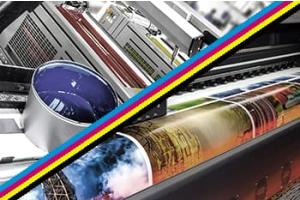Following our recent Geek Outs over Lithographic and Digital Printing, you may now be wondering: 'what's the difference?'
In this weeks Geek Out, we're looking at what separates the litho print from the digital print, and what other options are out there.
A Comparison
Lithographic |
Digital |
|
| Best for large print runs due to print plate set up cost being spread across more pages. |
Volume |
Very little set up costs and a quick turnaround makes digital printing perfect for low volume prints. |
| The lithographic method allows for the printing of high quality prints with a consistent image. |
Quality |
Digital print quality can be less consistent than lithographic, but the process is constantly improving. |
| Due to the creation of printing plates, lithographic printing has a much longer turnaround time. |
Time |
As digital printing has significantly less set up required, the turnaround time is much quicker. |
| The set up of the printing plates make the initial cost of lithographic prints relatively high, however the cost per sheet lowers at higher quantities. |
Budget |
Digital printing is much more cost effective for smaller print runs, as the process is much faster and efficient, but larger runs don't decrease in cost. |
| Lithographic printing uses CMYK colours and can also Pantone match, and print metallic or fluorescent inks. |
Colours |
Digital printing simulates the CMYK matching process, with theink distributed in accordance with a digitised image. |
| Lithographic printing plates require a lot of setup and can't print variable data, so each print in a run must have the same design. |
Personalisation |
Digitally printed products can be customised with variable data printing, allowing for personalised designs to be printed. |
Overall, Digital Printing is the best solution for lower budgets, shorter runs, or for personalised products, whilst Lithographic Printing is best for large print runs requiring a high quality print or special colour effects such as Pantone matching, fluorescent inks, or metallic print.
Alternative Printing Methods
Throughout the world of print, there is also a selection of other methods which are used to print on other materials or for specialty products. For example;
Wide Format Printing
Wide format printers are specialist printers that use a version of inkjet technology to print larger images such as banners, flags, and trade show graphics. These printers are usually designed to print on a roll which is fed through the machine, as opposed to being printed on individual sheets.
Screen Printing
Screen printing is a technique that involves ink being forced through a mesh-like stencil in order to print onto a wide range of surfaces such as textiles, wood, glass, vinyl, metal, and plastic. Screen printing can sometimes be used as a substitute for lithographic printing as it can use a variety or inks and fabrics, and it can also be used for the decorative process of Spot UV.
Dye Sublimation
Sublimation printing (also known as Dye Sublimation or Dye Sub) is a process which uses a heat press to seal an image onto a specially coated surface such as a mug. The heat allows the ink from the image to penetrate the printing surface to produce a permanent full colour image. This creates a long lasting and scratch-resistant finish, with the image combining with the print surface and making it more durable.











